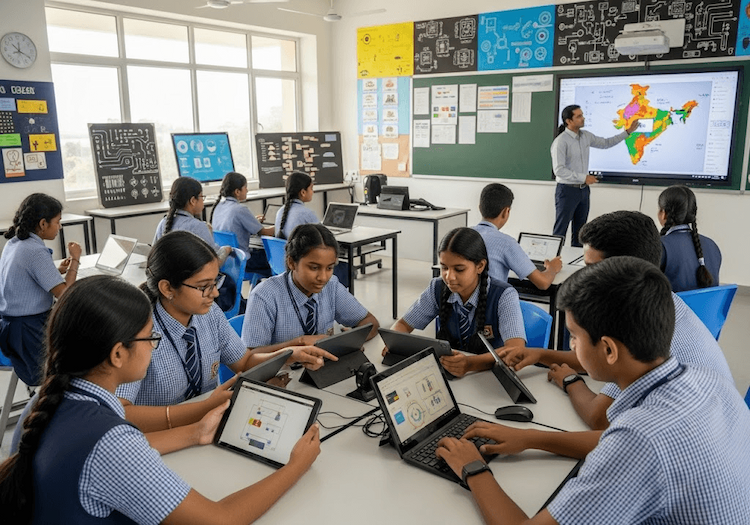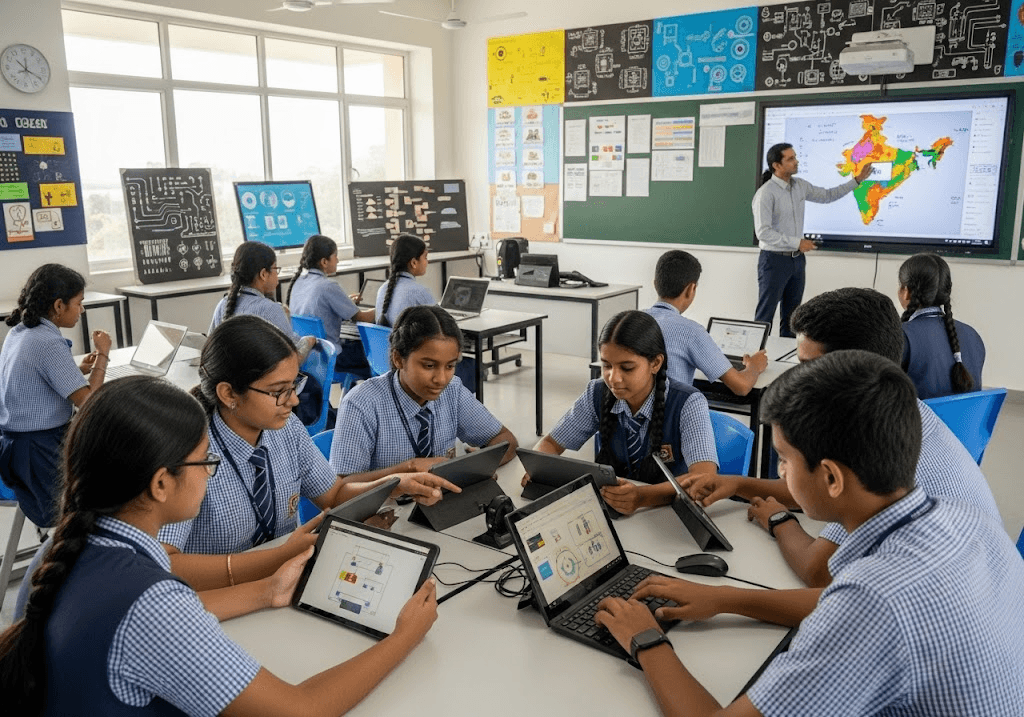
How Schools in Yelahanka Are Revolutionizing Education Through Technology

How Schools in Yelahanka Are Revolutionizing Education Through Technology
The educational landscape in Yelahanka has undergone a remarkable transformation in recent years. What was once dominated by traditional chalk-and-board teaching methods has evolved into a dynamic, technology-driven learning environment. Schools in Yelahanka are no longer just keeping pace with global educational trends; they're setting new standards for digital innovation in North Bangalore's academic sector.
Parents searching for quality education often input queries like best cbse schools near me or look specifically for the best cbse schools in bangalore. These parents increasingly find themselves drawn to institutions that seamlessly blend academic excellence with cutting-edge technology. This digital revolution isn't just about having computers in classrooms anymore; it's about creating immersive learning experiences that prepare students for tomorrow's challenges.
Smart Classrooms: The Heart of Modern Learning
Interactive Digital Boards Transform Teaching
- Replace traditional blackboards with touch-enabled smart boards
- Allow teachers to display multimedia content, videos, and interactive lessons
- Enable real-time collaboration between students and educators
- Support multiple learning styles through visual, auditory, and kinesthetic approaches
Multimedia Integration Enhances Understanding
- Complex scientific concepts become accessible through 3D models and simulations
- Historical events come alive through virtual reality experiences
- Mathematical problems are solved using interactive tools and visual aids
- Language learning incorporates pronunciation guides and cultural immersion videos
Best Schools in North Bangalore have recognized that smart classrooms aren't just about technology, they're about creating engaging environments where every student can thrive.
Digital Learning Platforms: Personalized Education at Scale
Learning Management Systems (LMS)
- Provide centralized access to course materials, assignments, and resources
- Track student progress through detailed analytics and reporting
- Facilitate communication between teachers, students, and parents
- Enable flexible learning schedules and remote access to educational content
Mobile Learning Applications
- Allow students to continue learning beyond classroom hours
- Offer practice exercises, quizzes, and educational games
- Provide instant feedback and performance tracking
- Support offline learning for areas with connectivity challenges
Cloud-Based Collaboration Tools
- Enable group projects and peer-to-peer learning
- Allow real-time document sharing and editing
- Facilitate virtual study groups and discussion forums
- Support seamless integration across different devices
AI-Powered Assessment and Personalized Learning
- Intelligent Tutoring Systems adapt to individual learning speeds and preferences
- Identify knowledge gaps and provide targeted interventions
- Offer personalized learning pathways for each student
- Generate customized practice materials based on performance data
Schools recognized among the best cbse schools near me, area use these advanced learning platforms to provide personalized education at scale.
STEM Labs: Building Future-Ready Skills
Robotics and Coding Programs
- Introduce programming languages appropriate for different age groups
- Develop logical thinking and problem-solving abilities
- Encourage creativity through robot design and programming challenges
- Prepare students for careers in technology and engineering
Innovation Labs and Maker Spaces
- Provide hands-on experience with 3D printing and digital fabrication
- Encourage entrepreneurial thinking and project-based learning
- Support interdisciplinary learning through technology integration
- Foster collaboration and creative thinking skills
Science Simulation Software
- Allow safe experimentation with dangerous or expensive procedures
- Provide unlimited access to laboratory experiences
- Enable students to visualize complex scientific phenomena
- Support inquiry-based learning and hypothesis testing
Parent Communication and Student Management Systems
Real-Time Progress Monitoring
- Instant access to attendance records, grades, and behavioral reports
- Regular updates on homework completion and upcoming assignments
- Direct communication channels between teachers and families
- Automated alerts for important school events and deadlines
Digital Fee Management and Administrative Services
- Online fee payment systems with instant receipts
- Digital document submission and approval processes
- Automated report card generation and distribution
- Streamlined admission and enrollment procedures
Leading best cbse schools in Bangalore and Schools in North Bangalore have discovered that effective parent communication technology strengthens the home-school partnership, leading to better student outcomes.
Challenges and Solutions in Technology Adoption
Infrastructure Development
- Ensuring reliable internet connectivity across all campus areas
- Upgrading electrical systems to support increased technology demands
- Creating secure networks to protect student data and privacy
- Maintaining and updating hardware regularly to prevent obsolescence
Teacher Training and Professional Development
- Comprehensive training programs for educators on new technologies
- Ongoing support and mentorship during technology transition periods
- Creating communities of practice where teachers share best practices
- Regular skill assessments to identify areas needing additional support
Digital Divide and Accessibility
- Providing device lending programs for students without personal technology
- Creating offline alternatives for students with limited home internet access
- Ensuring technology solutions work across different socioeconomic backgrounds
- Developing inclusive designs that accommodate students with disabilities
Benefits Transforming Student Experience
Enhanced Engagement and Motivation
Students show increased interest in learning when technology makes abstract concepts tangible and interactive. Virtual field trips transport classes to historical sites, while gamification elements make routine practice exercises enjoyable and competitive.
Improved Academic Performance
Data from technology-enabled schools, often searched for with keywords like best cbse schools near me, shows significant improvements in test scores, particularly in STEM subjects where visual and hands-on learning prove most effective.
21st Century Skill Development
Students naturally develop digital literacy, critical thinking, and collaborative skills that employers increasingly value in today's job market.
Preparation for Global Competitiveness
Technology integration ensures Yelahanka students can compete with peers from any metropolitan area worldwide, removing geographical barriers to educational excellence.
Looking Forward: The Future of Education in Yelahanka
The journey toward complete digital transformation continues as schools explore emerging technologies like artificial intelligence, augmented reality, and blockchain-based credentialing systems. Schools in Yelahanka are positioning themselves as pioneers in educational innovation, attracting families who value forward-thinking approaches to learning.
As we witness this technological revolution in education, it's clear that institutions embracing these changes are not just preparing students for academic success—they're cultivating the next generation of innovators, critical thinkers, and global citizens.
For parents seeking comprehensive information about educational opportunities in the region, SSA Bangalore North serves as an invaluable resource, providing detailed insights into school selections, admission processes, and academic standards across North Bangalore's educational landscape.
The technology revolution in Yelahanka's schools represents more than just a trend—it's a fundamental shift toward creating learning environments that truly prepare students for success in an increasingly digital world. As these institutions continue evolving, they're setting new benchmarks for educational excellence that benefit not just individual students, but the entire community's future prosperity.
Frequently Asked Questions
1. What technology tools are most commonly used in Yelahanka schools? Smart interactive whiteboards, tablets, learning management systems, and coding labs are the most prevalent technologies, along with AI-powered assessment tools and virtual reality equipment for immersive learning experiences.
2. How do schools ensure equal access to technology for all students? Many schools provide device lending programs, create technology resource centers, offer subsidized internet access, and develop offline learning alternatives to bridge the digital divide effectively.
3. Are teachers properly trained to use educational technology? Schools invest heavily in professional development programs, offering regular training sessions, peer mentoring, and ongoing technical support to ensure educators can effectively integrate technology into their teaching methods.
4. What role does AI play in personalizing education for students? AI systems analyze individual learning patterns, adapt content difficulty levels, provide customized practice materials, and help teachers identify students who may need additional support or advanced challenges.
5. How do parents stay connected with their child's digital learning progress? Parent portals provide real-time access to grades, attendance, assignment submissions, and teacher feedback, while automated notifications keep families informed about important updates and school events.
6. What safety measures protect student data and online privacy? Schools implement secure networks, use encrypted communication systems, conduct regular security audits, train staff on data protection protocols, and maintain strict privacy policies compliant with educational data regulations.
7. How does technology integration affect traditional teaching methods? Rather than replacing traditional methods, technology enhances them by making abstract concepts visual, enabling collaborative learning, providing immediate feedback, and allowing teachers to focus more on mentoring and creative instruction rather than routine tasks.
